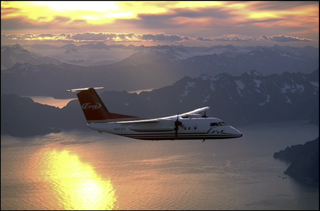Era Aviation, Inc.
Project Description
Summary:
ERA OPERATES THE LARGEST REGIONAL AIRLINE IN ALASKA
Era Aviation’s regional airline business is an independent operation that provides critical transportation services to remote cities and villages in Alaska that have limited air, road and rail access. Based on total passengers carried, Era is the largest regional airline in Alaska and is the 26th largest regional airline in the U.S.
- Era operates a fleet of 13 aircraft with seating capacities for 15 to 50 passengers.The Company transported approximately 350,000 passengers in 2003, averaging 83 flights per day.
- Era is a code share partner of Alaska Airlines, the leading major airline transporting passengers to and from Alaska.
- Era performs all services associated with passenger travel including baggage handling, plane turnaround, ticketing, in-flight service and most maintenance activities.
- In 2004, Era generated pro forma revenue and EBITDA of approximately $40.2 million and $6.7 million, respectively.
- The Company employs approximately 320 personnel, none of whom are covered by union agreements.
ALASKA IS AN ATTRACTIVE MARKET FOR AIRLINE OPERATIONS
Aircraft provide a more important means of transportation in Alaska than they do in many other areas due to Alaska’s limited road and railroad infrastructure. Many Alaska communities can only be accessed by air travel. Also, the remoteness of Alaska results in most interstate visitors to the state utilizing air travel, primarily to and from the Ted Stevens International Airport in Anchorage. Relative to most geographies, airline operations in Alaska face less competition from other modes of transport.
· Alaska is a vast region that totals 571,000 square miles, approximately 16% of the total U.S.
· Other than Anchorage, Alaska’s population of approximately 650,000 people is widely scattered:
– 260,000 live in Anchorage (40%) – 11 other cities have more than 5,000 people (12%)
– 31,000 live in Juneau (5%) – 42 cities have 1,000 to 4,999 people (16%)
– 30,000 live in Fairbanks (5%) – 291 cities have less than 1,000 people (22%)
· Alaska has only 29,000 road miles which would rank 47th among U.S. States and be approximately the same as Vermont, a state roughly 2% the size of Alaska.
· Mountain topography and the many inlets and bays of Alaska’s coastline have the impact of creating circuitous routes for many of the paved road options that exist.
· Rail lines are also limited. Vessel service is available for most seaside Alaska communities but is not well suited for the small personnel and cargo shipment requirements of Alaska’s numerous small communities.
OPERATIONS ARE FOCUSED ON TWO DISTINCT REGIONS
In its Anchorage network, Era conducts approximately 53 flights per day to 5 communities within 250 miles of Anchorage. Era operates more flights from Anchorage than any other airline and ranks third in terms of passengers enplaned from Anchorage. In its Bethel network, Era is focused on the needs of 17 small communities in the vicinity of Bethel, none of which have road access. Approximately 30 flights per day are conducted in the Bethel network. In both regions, Era is the leading provider of scheduled passenger service to its target communities, most of which receive limited service from other airlines.
Investment Considerations Were:
- Strong Market Position
- Era is the leading regional airline in Alaska.
- The Company has an exemplary safety record.
- Era has operated continuously in Alaska since the 1950s and has a well-established brand name and considerable goodwill.
- Attractive Market · Air travel is mostly of a non-discretionary nature in Alaska. Demand for service has been consistent.
- The growth in tourist travel to Alaska is expected to continue.
- The population of Alaska has historically grown at higher rates than the U.S.
- Era’s competition consists almost entirely of small, undercapitalized private companies.
- Significant Barriers To Entry
- Scheduled passenger service for planes of more than 10 passengers requires an FAR 121 certificate which is difficult and costly to acquire. Only two other regional airlines in Alaska have an FAR 121 certificate.
- Major airlines have cost disadvantages that inhibit them from pursuing this market.
- A new entrant would be required to make significant infrastructure investments to be in a position to compete within Alaska.
- Era’s code sharing agreement with Alaska Airlines is an advantage relative to other potential carriers.
- Attractive Financial
- Era’s pro forma historical financial results reflect consistent improvement in the operation of Era’s current routes. Pro forma EBITDA in 2004 was $6.7 million.
- Results
- Multiple growth opportunities exist. Era’s cost structure and existing infrastructure creates the opportunity for Era to expand its coverage throughout Alaska.
- Era’s asset base is well suited to support financial leverage.
- Loyal Employee Base
- Era is considered a preferred employer in the Alaska community. Employee turnover has historically been low. Era’s pilots and mechanics both average eight years tenure with the Company.
The Process:
After extensive due-diligence we determined that Era is a unique franchise and a great opportunity to own a company with a well established brand name and goodwill since the 1950s.
-Era Aviation Investment Group, LLC was formed in July of 2004 to negotiate and bid for Era Aviation Inc., at the same time raise the capital needed for the acquisition.
-EAIG finalized the term sheet for the acquisition in November of 2004
-EAIG finalized the negotiation and singed the Stock Purchase Agreement on the 27Th of May 2005
-EAIG Secured a Senior Credit facility and Revolver from Capital Source in July of 2005
-EAIG also completed the raise of capital in July of 2005
-The transaction closed on July 18, 2005
Note: THIS IS ONLY A SUMMARY, which includes certain projections with respect to the anticipated future performance of Piccadilly. Such projections represent predictions of future events based on various assumptions concerning anticipated results, which may or may not be correct, and should not be relied upon to indicate the actual results that will be obtained..


Project Details




